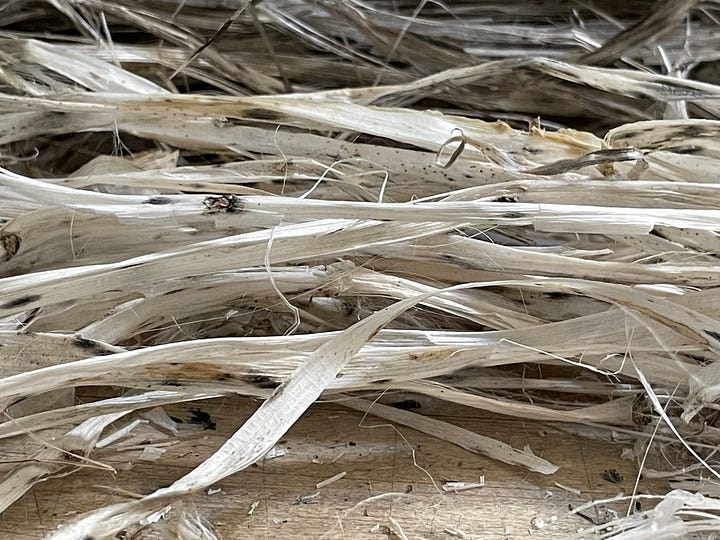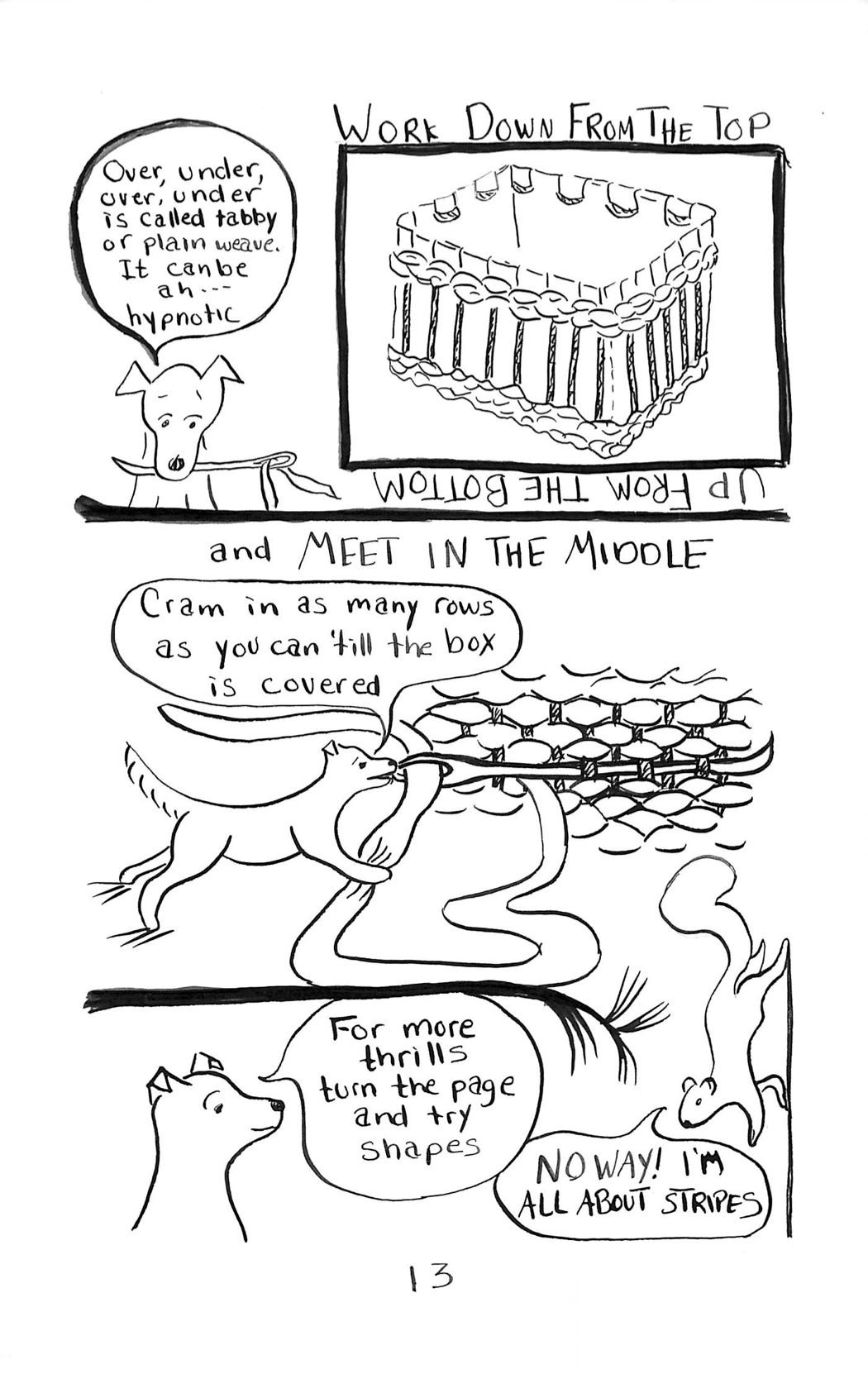And really, that does sum it up— for I have adopted a gem of a dog.
Or perhaps she has adopted me?
Either way, thrilling and normal as it already feels to have her here, I’m bowled over by my new friend.
Apparently I needed a sidekick. And so did she.
Not that it wasn’t intense at first — I mean, we’d never met before. But after the first confused hours, the hardest part for me has been figuring out how best to draw her. And if we’re going to be together as much as I think we will, I’ll have to learn.
It’s not that I haven’t drawn dogs before.
Between the comic series Enid & Crow and the guide How to Weave a Bag on a Box,1 I got a fair bit of practice once upon a time.
But it has been a while. And finding a comic persona for a real live being you’re just getting to know takes time and practice. What size is she— especially compared to me? How big are her ears? Can I exaggerate them. What color best describes her dappled coat?
And what is her name???
Despite both a certain resemblance to my other two beloved Australian Cattle Dog/Blue Heelers2 and a certain general sameness to the way I draw animals of the canine variety, I do want to make sure she appears here as her own mysterious and interesting self.
Because each of us is her own mysterious self, and I hope, both in real life and our comic adventures, we can relish the pleasure of getting to know one other’s quirks, habits and personalities.
Happily, so far, we’re both eager to be pleased—
—and each day of our seven so far has seen us relax, whether walking hither and yon, or sitting quietly in the same place for more than a few moments.
But still— is she indigo, malachite, hematite, carbon black or a combination of all four? Could it be that her color changes with the day? Like my clothes?
How fun would that be? And why not let our colors add another level of pleasure to a companionable walk on warmish spring morning during which we also happen find another armload of dead milkweed?
And how much more pleasurable is it to experiment with said milkweed by working side by side in companionable focus: Beryl keeping one eye on me and one on the squirrels (my studio has a sliding door with an excellent tree view),
while I keep one eye on Beryl and the other on the now substantial pile of milkweed.
And then eventually to both relax enough so she could ignore the squirrels and I could turn two eyes to my work—a good thing as I soon decided to introduce some very sharp objects into my preparation process.


I hadn’t thought to try them before, but in answering Jaya’s question about spinning vs cordage in last week’s post I was reminded that I’d once used this make-shift mini-comb set-up to clean and organize green-gathered milkweed fibers, and thought such a thing might work on these dry bark strips as well.


Which they did.
The process generated a fair bit of tow--perhaps more than if I’d continued with the one-strand-at-a-time damp-peeling method I described last week--but it felt worth it. (I also may have noticed the volume of short bits because it all happened so fast--the downside of efficiency, I suppose). Honestly though, it didn't worry me; there is plenty of good fiber left in three general lengths, and as I recall there was no shortage of short tow scraps with the green milkweed combing too.3
Because you never know what you might like, I carded the best of these bits of bark-filled tow into messy rolags to store and spin into some sort of yarn one of these days. It looks a mess, but maybe it’ll be wonderful. For now though, I'm going to focus on the long fibers and splicing,4 a technique used in the creation of prehistoric textiles that I've known about for a while but never tried until now. Re-inspired by Mackenzie Kelly-Frére's recent experiments (see link #5 in footnote #4 below), which oddly coincided on Instagram with last week's post, he in turn led me back Sally Pointer's amazing videos (other links in footnote #4), which I highly recommend.
But reading a paper, watching a video and actually trying with real materials are very different things and in my hands—all three or four yards of singles I’ve tried--splicing feels more than a little tenuous. Still, practice is a thing, and I look forward to learning more by doing5 rather than imagining. Yard for yard, it may not only be a way to create finer finished yarn, but also be a more efficient use of my limited hand strength as there is less finger twisting overall ; if so, splicing is definitely a thing I'll want to add into my skill set.6
If not, there is still cordage twisting as I can, a thing I adore and will continue with either way. How not to relish creating yarn that matches your dog?
How not to relish drawing practice too.
Having a sidekick is a fine thing— especially in storytelling. Enid & Crow a long form comic series about the life and adventures of Enid (a plain air embroiderer), features Crow (a dog), and was my first sequential pen and ink comic. It was a delight to create and I got to draw a lot of yarn. And a dog. The comic ended rather abruptly after a few years though, when Crow went off to work on a comic guide, How To Weave A Bag On A Box, which featured her sidekick Phineas (a squirrel). Phineas then appears again in the Sarah Dippity Skirt guide, but was replaced by a silent and unnamed rabbit in Of Coffee Filters and Rabbit Holes. I was my own sidekick in Backstrap Dialogues —the dialogue being a conversation between to aspects of myself, The Luminist and The Storymaker whose line of banter, perhaps not unexpectedly, vaguely resembled that of Phineas and Crow.
Scarface was my constant companion from the day she was born in a half built cabin in a canyon in 1981 until she died in 1997. Sirius, coincidentally born a mile away in the same canyon, looked after me from 2000 till 2018. Beryl on the other hand, has a mostly unknown but certainly eventful past. In the months since her initial rescue by the side of the road she’s had puppies, traveled from a place of overflowing shelters to one near here, and had to adjust to several foster situations as well as what I hope is her forever niche right here. All of this makes her way easier than a puppy in some ways (she’s beautifully house trained and knows what to do when I say “sit”), and also kinda nervous about all sorts of things. And how not?
Two blog posts on preparing green milkweed: the first where I was a little cock-a-hoop about all the things I was figuring out, and the second where I had learned another slightly harder lesson— one that might expand on my response to Jaya’s question about spinning vs cordage making.
Sally Pointer’s Youtube Channel — an amazing library of delightful and informative videos on all manner of practical historic textile techniques
The Original Paper by Glebe and Harris: The First Plant Bast Fiber Technology: identifying splicing in archaeological textiles
Many Thanks to Mackenzie Kelly-Frère for the link, the reminder and endless inspiration
I might also need to wait for summer/fall green milkweed to really get a handle on splicing, for according to Sally Pointer, some of the success of the technique relies on the the pectins on the fibers sticking together quite well, esp when activated by saliva, pectins that are long gone on my winter retted strands.
Have you tried it? If so, do let me know what you thought/learned etc. It’s exciting stuff






















I understand dog bliss perfectly. She looks perfect.
Yeah! A Dog for you and a person for Beryl.